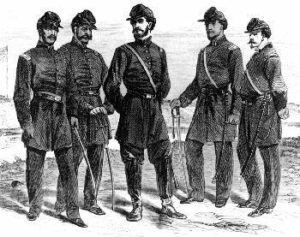
*On this date, in 1862, the 1st Louisiana Native Guard was formed.
They were later the 73rd Regiment Infantry U.S. Colored Troops and were among the first all-black regiments to fight in the Union Army during the American Civil War. They were based in New Orleans, Louisiana, and played a prominent role in the Siege of Port Hudson. Their members included some free men of color from New Orleans; most were Black former slaves who had escaped to join the Union cause and gain freedom.
After New Orleans fell to Admiral David Farragut in April 1862, Union Maj. Gen. Benjamin F. Butler headquartered his 12,000-man Army of the Gulf in New Orleans. On September 27, 1862, Butler organized the Union Army's 1st Louisiana Native Guard regiment, some of whose members had served in the previous Confederate Native Guard regiment. Free men of color had served with the militia since the French colonial period. However, the regiment's initial strength was 1,000 men, composed mostly of former Black slaves who had escaped to freedom. The Union commissioned several Blackline officers of the Guard.
Former Confederate Lt. Andre Cailloux, a Creole of color (free man of color) in New Orleans, was named captain of Company E. P. B. S. Pinchback; also a free man of color, was appointed as captain of Company A and later was reassigned as company commander of the 2nd Regiment. (He later served as governor of the state, as a US Representative, and as Senator.) James Lewis, a mixed-race, former steward on the Confederate river steamer De Soto, was commissioned as captain of Company K. During this period, some slaves who escaped from nearby plantations joined the regiment. Still, the Union Army's official policy discouraged such enrollments.
In November 1862, the number of escaped slaves seeking to enlist became so great that the Union organized a second regiment and, a month later, the third regiment. The field-grade officers of these regiments were white men, except Major Francois Ernest Dumas of the 2nd Regiment, a Creole of color. Colonel Spencer Stafford, formerly Butler's military "mayor" of New Orleans, was the original white commander of the 1st Louisiana Native Guard. In June 1863, the 1st, 2nd, and 3rd Louisiana Native Guard Regiments were redesignated as the 1st, 2nd, and 3rd Corps d'Afrique. Perhaps 200 to 300 of the original 1,000 members of the 1st Louisiana Native Guard made this transition.
Poor treatment by white soldiers and difficult field conditions resulted in many black officers resigning and enlisted soldiers deserting the Corps. In April 1864, the 1st Louisiana Native Guard was dissolved, and its members joined the newly organized 73rd and 74th Regiments of the United States Colored Troops of the Union Army. By the war's end, about 175,000 Blacks had served in the 170 regiments of the United States Colored Troops. Most Guard soldiers were Blacks who had escaped slavery and joined the Union effort. Some historians think the legend of the continuity of the regiments was a propaganda ploy by Union General Butler.